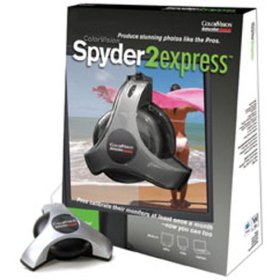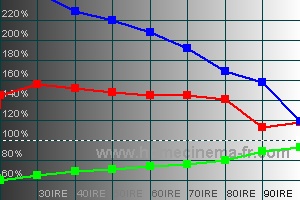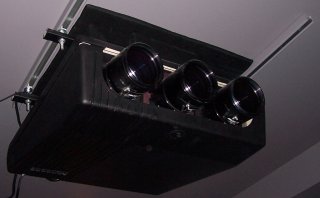Well, the title makes it sound like I actually did something with the projector – and the truth is I’ve had very little time to mess around with things lately. I did recently have an opportunity to A/B compare (very quickly) the Ampro and a Sanyo Z5 (Matt was kind enough to bring his over). There was an astonishing difference in black level (where CRTs always out-do a digital) and more surprisingly, colors. If you watched either image for a short while – you’d quickly get used to the look and things were ok. It really makes you wonder if people fuss too much about calibration..
I recently purchased a Sypder2 Express kit. This has both Mac and Windows software to (mostly) automatically adjust your monitor to be correct. For $100CDN it seemed like a reasonable purchase. Especially since the HCFR software also supports the spyder2 sensor and I can use it for the projector too.

The soffrware is pretty straight-forward, and I did a tune up on the mac mini. The downside to the Express software is that there are very few knobs to turn, you get what they decide is best. It does lets you do an A/B comparison between the original and the calibrated, and I wasn’t really that impressed – sure the test image looked better, but not so much better that I was floored.
Then we checked out some of the digital pictures (and videos) stored in iPhoto. WOW. It made a huge difference. I’ve always believed that calibration mattered, and the color accuracy was important but seeing the images post calibration really sold me on how big a difference it can make.
The HCFR Colorimeter software can be found here. Version 1.2.2 is what I downloaded. It supports the Sypder2 sensor and has english language support – including help. The english appears to be mostly machine translated, but that’s good enough. The Google translate service is pretty handy to surf the HCFR forums to read up on various things, and I know that AVS has had several threads on HCFR usage.
In order to get your Sypder2 sensor to work with the HCFR software you need to copy the cvspyder.dll from the DataColor software into somewhere the HCFR software can see it. The simple way to do this and have the right drivers installed for your sensor is to install the Spyder2Expres software (no need to run it, just install). Then assuming you’ve used defaults for everything copy cvspyder.dll from C:\Program Files\ColorVision\Spyder2express to C:\Program Files\Colorimeter_HCFR. This will allow the HCFR software to use the sypder2 sensor.
I’ve done some simple testing to ensure that the software/hardware was working – but I’ve yet to sit down with the sensor and my Ampro CRT to see how things look, and if I can figure out what to do in order to improve things. At this point, I’ve got the tools in hand. I will need to build some manner to allow me to mount the spyder2 sensor on a tripod and I’ll need to read up on using DVE to get the right test patterns up on the screen. HCFR supports a manual DVD mode, and they have a PAL format DVD image with some test patterns on it – but the test patterns are all very basic (IRE10, IRE20, ..) so DVE should have all the things I need.
Hopefully I’ll get to part two soon..


